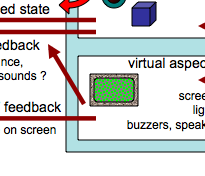I’ve just spent best part of 2 hours simply trying to print some Powerpoint slides as PDF, only to discover it is yet more of the incompetence in Office 2008 that I have previously blogged about (pain, tears and office 2008). I was trying to get a small PDF for the web and so was printing to a postscript file and then converting to PDF using Adobe Distiller, but Distiller kept crashing with broken postscript commands (I assume it would also have failed to print on a printer). Strangely if I printed straight to PDF it would view OK, but would again crash if I asked Acrobat to process it to reduce the file size.
After doing a lengthy ‘binary chop’ on the file, printing smaller and smaller segments, I narrowed it down to one slide, and then a single element on the slide that of deleted made it all work OK.
I had assumed the problem would be some big JPEG image that I had imported, but the offending element turned out to be the little patterned rectangle in the center of the excerpt below.

The little rectangle is supposed to represent a screen and was constructed simply from two Powerpoint shapes, a plain rectangle and a rounded rectangle laid on top of one another. I assume the complication was that I had used one of the built-in textures in the previous version of Powerpoint (yes backward compatibility again). I can only assume that Powerpoint encodes these textures in some unusual way and that the newer version of Powerpoint gets confused when it comes to print them (even though it appears to display them fine).
In meetings related to the UKCRC Grand Challenge on Memories for Life, there have been frequent worries, not least from the British Library, about digital preservation, how digital materials from some years ago are hard to access today. A key example was the BBC ‘Doomsday Book’ project that created a two volume interactive multimedia videodisc in 1986, but by 2002 this was virtually unreadable and was only just saved (see 2002 BBC News article). This was ‘just’ 15 year old technology compared to the 1000 year old original Doomsday Book that is still readable on paper.
However, with Powerpoint we are not just seeing digital preservation problems from 15 year old technology, but between two subsequent versions of the same ‘industry standard’ software on some of its most basic features (static geometric shapes). The British Library worries about a new digital dark age … and Microsoft’s coders seem to be hell bent on making it happen.